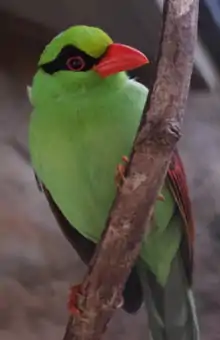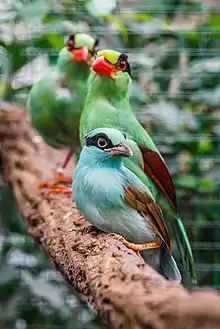Javan green magpie
The Javan green magpie (Cissa thalassina) is a passerine bird in the crow family, Corvidae. This critically endangered species is endemic to montane forests on the Indonesian island of Java.[1][2] It formerly included the Bornean green magpie as a subspecies, in which case the "combined" species was known as the short-tailed magpie.[2]
| Javan green magpie | |
|---|---|
 | |
| Individual at Chester Zoo | |
| Scientific classification | |
| Domain: | Eukaryota |
| Kingdom: | Animalia |
| Phylum: | Chordata |
| Clade: | Dinosauria |
| Class: | Aves |
| Order: | Passeriformes |
| Family: | Corvidae |
| Genus: | Cissa |
| Species: | C. thalassina |
| Binomial name | |
| Cissa thalassina (Temminck, 1826) | |
Once common, the species has declined drastically as a result of habitat loss and illegal capture for the wild animal trade.[3] The size of the remaining wild population is unknown, but perhaps only around 50 individuals,[3] while others speculate that the lack of recent sightings might mean that it already is extinct in the wild.[4]
In an attempt at saving the species, a captive breeding program based on confiscated individuals has been initiated by the Cikananga Wildlife Center in Java (since 2011) and a few European EAZA zoos (since 2015).[3][5] It has successfully bred at both the Javan and European facilities,[4][5] and as of 2018 this captive population had reached about 50 individuals.[6]
Appearance
Javan green magpies are primarily a vivid green, with a black "mask" marking around their eyes, russet wings, and white tertiary feathers. They have bright red beaks and eyerings; their legs are equally bright, ranging from red to orange. Their eyes are dark brown and they have a relatively short tail.

The bright green plumage is the result of a combination of structural coloration, and the yellow pigment lutein, which they gain from their insect diet.[3] They also feed on small lizards and frogs.[4]
In captivity, adults turn bluish (the structural colour of their feathers) if their diet is inadequate in lutein.[3]
Young
Javan green magpies lay cream coloured speckled eggs[7] and are altricial, hatching with no feathers, completely dependant on their parents. A fledgeling's initial plumage is bluish, with the dark face and wing markings. They have beige-brown beaks and eyerings with light orange legs. After their first moult they become green.[5]
References
- BirdLife International (2018). "Cissa thalassina". IUCN Red List of Threatened Species. 2018: e.T22724821A134213647. doi:10.2305/IUCN.UK.2018-2.RLTS.T22724821A134213647.en. Retrieved 19 November 2021.
- Van Balen S et al., 2011. Biology, taxonomy and conservation status of the Short-tailed Green Magpie Cissa thalassina from Java. Bird Conservation International FirstView Article, pp 1-19.
- Gill, Victoria. "Sold for a song: The forest birds captured for their tuneful voices". BBC News. Retrieved 31 December 2017.
- "The secret life of the zoo captures a moment an endangered bird hatches". Chester Zoo. 12 December 2017. Archived from the original on 9 August 2018. Retrieved 18 May 2018.
- "Javan Green Magpie". Cikananga Wildlife Center. Retrieved 18 May 2018.
- "Prague zookeepers use puppet to feed endangered magpie". The Telegraph. 17 April 2018. Retrieved 10 July 2018.
- "Hatching of Javan Green Magpies caught on film for the first time, #ornithology news via @RareBirdAlertUK". www.rarebirdalert.co.uk. Retrieved 2023-04-03.
